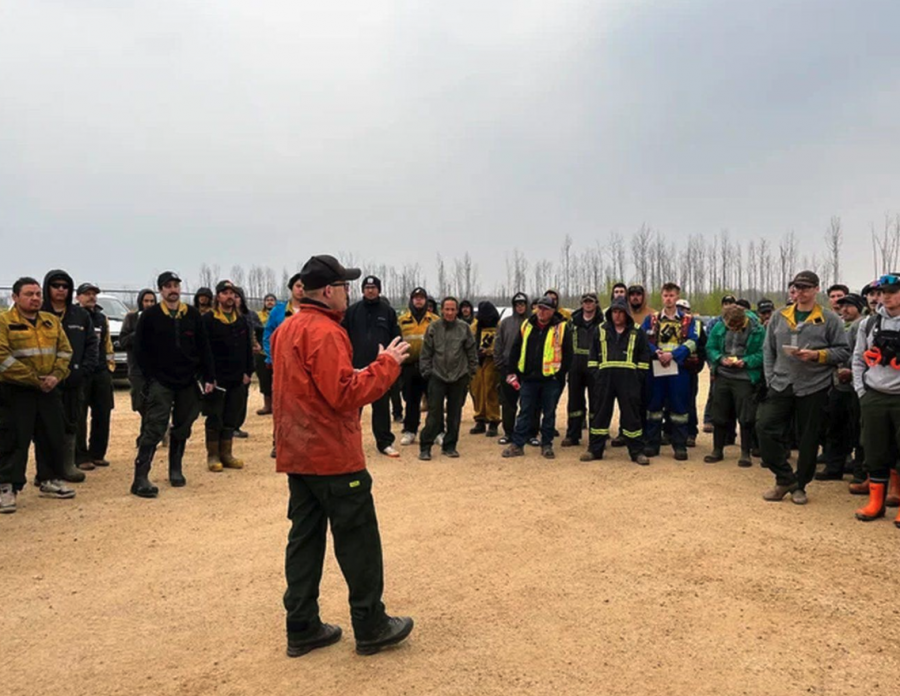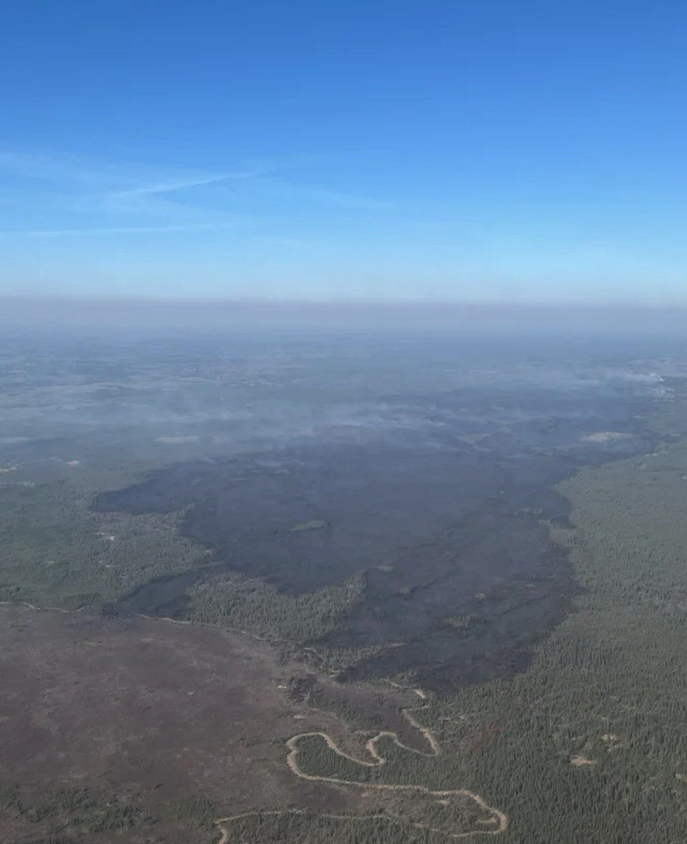Search VernonNow
(UPDATE: May 13 at 6:01 pm): Crews battling an out-of-control wildfire outside Fort McMurray, Alta., were expecting a little help from light rain and favourable winds on Monday.
"We are expecting a little help from the rain," said provincial wildfire information officer Christie Tucker.
"The wind direction has changed. The winds are no longer pushing the wildfire in the direction of the community."
The fire near the oilsands hub, northeast of Edmonton, had grown to about 65 square kilometres. Officials said that's because they have a more accurate estimate not because flames are spreading.
The fire remained about 16 kilometres from the city of 68,000 people. A fire there in 2016 destroyed roughly 2,400 homes.

Meanwhile, firefighters continued to work on another main fire in the province. A 14-square-kilometre blaze near the city of Grande Prairie in northwestern Alberta was facing extreme wildfire conditions, with gusty winds and no precipitation in the forecast.
"Fire behaviour could increase (Monday) and there's no precipitation anticipated for that specific area," Tucker said.
That fire is about four kilometres from the hamlet of Teepee Creek, the closest community to the flames.
Josh Morin of Alberta's public safety department said no new evacuation alerts or orders were issued Sunday or Monday.
Two evacuation orders, issued Friday, remained in place for areas near Grande Prairie and the Municipal District of Greenview. Those areas are lightly populated.
Evacuation alerts have been issued for several regions in the Fort McMurray area, including Saprae Creek Estates, Gregoire Lake Estates, Fort McMurray First Nation and Anzac.
Structure protections were being set up as precautions in Gregoire Lake Estates and the First Nation, as well as an industrial park near the city.
On Monday, heavy equipment was working on a fire guard on the northeast side of the blaze, while six firefighting crews continued to establish a containment line, supported by 13 helicopters and air tankers on standby.
Crews were reinforcing a fire guard constructed over the weekend. Heavy equipment teams were also working on the fire's perimeter and air tankers and helicopters were dropping water on flames.
Tucker said firefighters have noticed several privately operated drones flying near wildfires. Such flights endanger firefighters, hamper efforts to extinguish the flames and are illegal, she said.
"There have been people who have been attempting to view the wildfire with a drone," Tucker said. "We need people to know they can't do that."
(UPDATE: May 13 at 12:45 pm): Crews battling a wildfire outside Fort McMurray, Alta., are expecting a little help from the weather.
Predicted light showers near the oilsands hub, northeast of Edmonton, are expected to help lower fire activity and give crews a jump on containing the flames.
The out-of-control fire has grown to about 65 square kilometres, but officials say that's because they have a more accurate estimate not because flames are spreading.
The fire remains about 16 kilometres from the city of 68,000 people.
A massive wildfire there in 2016 destroyed roughly 2,400 homes.
An evacuation alert Friday night remains in effect for the city as well as Saprae Creek Estates, Gregoire Lake Estates, Fort McMurray First Nation and Anzac.
On Monday, heavy equipment was working on a fire guard on the northeast side of the blaze, while six firefighting crews continued to establish a containment line, supported by 13 helicopters and air tankers on standby.
Structure protections were being set up as precautions in a residential area outside Fort McMurray and the First Nation, as well as an industrial park.
Meanwhile, crews fighting a blaze near Grande Prairie were expecting unfavourable winds and no rain.
A 14-square-kilometre wildfire remained out of control in the County of Grande Prairie and four kilometres from the hamlet of Teepee Creek.
Parts of the rural area were evacuated Friday night.
Dry, southeast winds were expected to fan the flames and fire behaviour was expected to increase.
Crews were reinforcing a fire guard constructed over the weekend. Heavy equipment teams were also working on the fire's perimeter and air tankers and helicopters were dropping water on flames.
(Original story: May 13 at 5:01 am): Fort McMurray's mayor took to social media to deliver a pep talk Saturday as the northern Alberta city once again faces the threat of an out-of-control wildfire that's spurring memories of a massive blaze that destroyed homes and buildings eight years ago.
"I know everyone's feeling unsettled and stressed right now. Our community knows all too well how this feels, but our past experience also means we are very well prepared to handle whatever comes our way," Regional Municipality of Wood Buffalo Mayor Sandy Bowman said in a video message posted to Facebook on Saturday.
Thousands of residents of Fort McMurray and the nearby community of Saprae Creek remained on an evacuation alert as a wildfire burned approximately 16 kilometres southwest of the city, meaning they should be ready to evacuate at short notice.
That alert notice, originally issued Friday, was expanded Saturday afternoon to also include the Gregoire Lake Estates neighbourhood south of Fort McMurray, as well as Fort McMurray First Nation #468, Anzac and and Rickards Landing Industrial Park.

Alberta Wildfire said the blaze had grown to almost 1,500 hectares in size by Saturday afternoon. While the agency said fire activity was expected to pick up in the afternoon as winds increased, the municipality said those winds appeared to be pushing the flames farther south, rather than towards the city.
Highway 63, the main route from Fort McMurray to the south, remained open but the municipality said in its latest update that it was expected to close later Saturday. An alternate route, Highway 881, which connects with Highway 63 south of Fort McMurray, was expected to be unaffected.
"Our region has shown tremendous resiliency and courage in the past and know we will all pull together to help our family, friends and neighbours," Bowman said in his online video.
Fort McMurray has a population of about 68,000. A wildfire there in 2016 destroyed roughly 2,400 homes.
"The most important thing you can do is remain prepared, stay calm, stay informed," Bowman said.
"Just know that everyone involved is working hard to control this wildfire and to ensure the safety of everyone in our region."
Alberta Wildfire said heavy equipment was being used to build a fire guard on the east side of the fire south of Fort McMurray. The provincial agency said nine helicopters and airtankers worked on the fire Saturday, in addition to crews fighting the blaze on the ground.
In northwestern Alberta, other fires in the County of Grande Prairie Number 1 and the Municipal District of Greenview Number 16 had forced residents of some rural areas from their homes.
Residents of Edmonton, meanwhile, woke up to smoky skies on Saturday morning due to a fire burning in another province altogether.
Environment and Climate Change Canada meteorologist Heather Rombough said most of the smoke blanketing Edmonton was coming from a fire that's forced thousands of people to evacuate in northeastern British Columbia.
The thickest smoke, which prompted a special air quality statement for the city, could clear by Sunday, Rombough said.
"But then there might be some smoke that lingers around through the next couple days, like into early next week at least," she cautioned.
The province is reminding people that drones are not allowed to be flown within five nautical miles, or 9.3 kilometers, of a wildfire since it interferes with aerial firefighting operations.